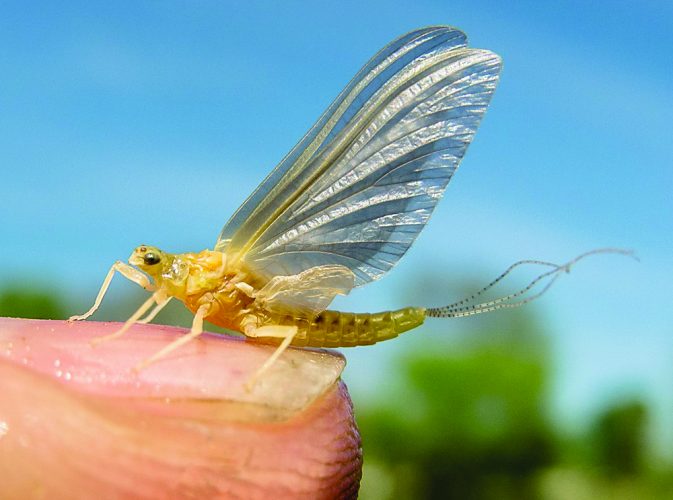Photo for the Mirror by Walt Young
Mayflies are elegant, delicate insects that have fascinated fly anglers for generations.
The month of May can be the best time of year for fly anglers in central Pennsylvania.
Several factors contribute to that wonderful possibility. Pleasant spring weather and optimal water conditions can make a day on a trout stream a near perfect experience. May is also the time of year many fly anglers dream of encountering a mayfly hatch on their favorite stream and with it the hope of great dry-fly fishing as the trout pluck the emerging flies from the water’s surface.
Mayflies are responsible for much of the foundational strategy and tactics of fly-fishing. Countless fly patterns have been created to imitate the more prolific species of mayflies found in our trout streams. When I started fly-fishing, I studied mayflies intensely because they are so important to so many aspects of the sport. I continue to be fascinated by these beautiful and important aquatic insects.
Currently, about 500 different species of mayflies occur in North America in both the flowing waters of rivers and streams and the still-water environments of lakes and ponds. Some are tiny, just a few millimeters long, while others are quite large with bodies an inch and a half or more long.
Mayflies are uniquely elegant and delicate insects. At rest, they hold their wings upright like tiny sailboats. They have slender abdomens and two or three wispy tails.
Mayflies are not just a phenomenon of the month of May. While many of the most significant hatches of mayflies occur from mid-April through early June, these insects I have witnessed fishable hatches of them from early March until November on streams in our area.
Any emergence of mayflies, however, can be a wondrous natural spectacle for nature enthusiasts and fly anglers alike. Some are a mere handful of bugs dribbling off just enough to spur the interest of the fish while a few others come off in incredible numbers. Each has its own niche in the remarkable ecosystem of any trout stream.
Mayflies are one of the oldest forms of insect life, with fossil records documenting their existence more than 200 million years ago. But the life cycle of mayflies is even more remarkable than their longtime presence here on Earth.
Most species of mayflies have a lifespan of almost exactly one year, beginning when the adult female mayflies lay their eggs in the waterway from which they came. The eggs hatch into tiny nymphs that live and grow primarily on the stream bottom. Different families of mayfly nymphs typically occupy different types of underwater habitat. Some cling to rocks in areas of fast-moving current, others burrow into the stream bottom for shelter, and a few species can swim like tiny minnows. Because mayfly nymphs can be present in great numbers in so many areas of a stream or lake, they represent a most important link in the food chain for many species of fish and other aquatic creatures.
After living underwater for an entire year, the nymphs of a given species finally reach maturity and undergo a quick and amazing conversion to their adult stage. In simplest terms, these underwater bugs leave the water and turn into winged adults that now breathe air and can fly. This incredible transformation happens in a period of seconds, and during the process, the outer skin of the nymph splits open, and the winged adult literally crawls out of its own skin. Some species of nymphs leave the stream bottom and swim to the water’s surface to emerge, while others crawl to shore or onto rocks, logs or other streamside objects to hatch. During these periods of emergence, many individual mayflies will be swept along the surface at the mercy of the current. This situation can provoke trout into a frenzy of surface feeding that many fly anglers covet so highly.
Fly-fishermen call the newly hatched adult mayflies “duns,” while biologists refer to them as “subimagos.” The duns fly from the water and retreat to streamside vegetation, where they rest before undergoing a final molt day or two later. Mayflies are the only insect that molts in its winged stage. Fishermen call this final stage “spinners” and scientists call them “imagos.”
The male and female spinners meet in swarms over the water and mate in flight. The females then deposit the fertilized eggs into the water to produce the next generation of their species. Their mission completed, the females die soon after and often drop to the water. This so-called spinner fall can sometimes produce a steady parade of dead and dying spinners floating on the surface, which can prompt as many or more rising trout than the hatching duns will.
Mayflies are completely benign insects. They don’t bite, sting, damage crops or bother humans in any way. In fact, adult mayflies live only a day or two and eat nothing during that time because they have no mouth parts for a digestive system.
Their only function in their adult stage is reproduction. Although it would seem that mayflies are of little importance other than to fly anglers who rely on them to produce activity for their sport, that is not true. Mayflies are reliable indicators of water quality because many species of mayflies cannot tolerate water pollution.
Their abundance generally signifies a stream or river with good water quality, while the decline of disappearance of mayfly populations can warn of a waterway in trouble.
Credit: Source link































